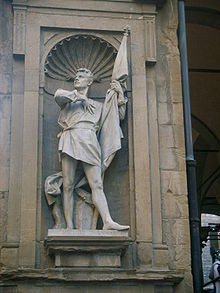- Ciompi
-
The Revolt of the Ciompi was a popular revolt in late medieval Florence by wool carders known as ciompi (Italian pronunciation: [ˈtʃompi]), who rose up in 1378 to demand a voice in the commune's ordering.
In late medieval Florence, the disenfranchised ciompi ("wool carders") were a class of labourers in the textile industry who were not represented by any guild. The ciompi were among the most radical of the lower-class groups, vegetable sellers and crockery vendors and the like, and resented the controlling power that was centred in the Arte della Lana, the textile-manufacturing establishment which guided the economic engine of Florence's prosperity, and was supported by the other major Guilds of Florence, the Arti maggiori.
Revolt of the Ciompi
Statue of Michele di Lando, Loggia del Mercato Nuovo, Florence
In 1378, ciompi launched the Revolt of the Ciompi, a briefly successful insurrection of the disenfranchised lower classes, the popolo minuto, which remained as a traumatic memory for members of the major guilds and contributed to the support given to the Medici a generation afterwards, as stabilizers of Florentine order. The revolt briefly brought to power in 14th-century Florence an unprecedented level of democracy. The ciompi were defeated by the more conservative elements in Florentine society when the major and minor guilds closed ranks to re-establish the old order, a counter-revolution in which the knight Salvestro de' Medici played a prominent role.
In June 1378, the unguilded wool-workers took up arms and attacked government buildings. On July 22, the lower classes forcibly took over the government, placing the wool carder Michele di Lando in the executive office of gonfaloniere of justice, and showing their banner at the Palazzo della Signoria.They compelled the governing body, the Signoria, to establish additional guilds in order to grant the ciompi access to political office. [1] During the time of ciompi control, they demanded the right to elect three of their own priors, the reduction of judicial corporal punishment, and reform the tax system.[2]
Conflicts between the traditional guilds and the ciompi became evident. On August 31, a large group of the ciompi that had gathered in the Piazza della Signoria were attacked by forces of the major and minor guilds led by the guild of butchers.[3] In reaction to this revolutionary episode, the new ciompi guilds were abolished, and within four years the dominance of the major guilds was restored. By 1382, all the reforms that the ciompi had introduced had officially been eliminated.
The event was a traumatic episode for the Florentine upper classes. More than a century later, Niccolò Machiavelli's Florentine Histories depicts the revolt with a series of invented debates and speeches that reflect the positions of the protagonists, seen from the patrician point-of-view of a later champion of state stability. As might be expected, the sculpture of the popular leader Michele di Lando (illustration, right) was not placed in a niche on the facade of the loggia in the Mercato Nuovo until the late nineteenth century, by which time historians of the Romantic generation had recast him as a leader of the people.
References
- ^ Hibbert, Christopher "The House of the Medici: Its Rise and Fall" pp.26-27
- ^ King, Margaret "The Renaissance in Europe" pp. 38-39
- ^ King, Margaret "The Renaissance in Europe" pp. 38-39
- Brucker, Gene A. "The Revolt of the Ciompi", in Florentine Studies (1968).
- Brucker, Gene A. Florence: The Golden Age, 1138–1737. New York: Abbeville Press, 1984 (hardcover, ISBN 0-89659-457-2); Berkeley: University of California Press, 1998 (paperback, ISBN 0-520-21522-2).
- Chronicles of the Tumult of the Ciompi (Monash publications in history; 7) by Rosemary Kantor and Louis Green (translators). Clayton, Vic.: Monash University, 1991 (paperback, ISBN 0-7326-0212-2).
- Cohn, Samuel Kline, Jr. The Laboring Classes in Renaissance Florence (Studies in social discontinuity). New York: Academic Press, 1980 (hardcover, ISBN 0-12-179180-7).
- Cohn, Samuel Kline, Jr. Lust for Liberty: The Politics of Social Revolt in Medieval Europe, 1200–1425. Cambridge, MA; London: Harvard University Press, 2006 (hardcover, ISBN 0-674-02162-2).
- Hibbert, Christopher "The House of the Medici: Its Rise and Fall". William Morrow Paperbacks, 1999 (ISBN: 0-688-05339-4)
- King, Margaret L. "The Renaissance in Europe" (ISBN: 0-072-83626-1)
- Leibovici, Martine. "From Fight to Debate: Machiavelli and the Revolt of the Ciompi", Philosophy & Social Criticism, 2002, Vol. 28, No. 6, pp. 647–660.
- Marks, L.F. "Fourteenth-Century Democracy in Florence": [Review Article: Florentine Families and Florentine Diaries in the Fourteenth Century: Studies in Italian Medieval History Presented to Miss E.M. Jamison, P.J. Jones (ed.)], Past and Present, No. 25. (Jul., 1963), pp. 77–85.
Categories:- Popular revolt in late-medieval Europe
- Late Middle Ages
- History of Florence
- 14th-century conflicts
- 1378 in Europe
- 14th century in Italy
Wikimedia Foundation. 2010.

